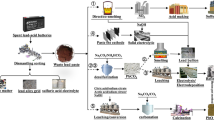Abstract
Electrical electronics constitute a significant quantity of municipal solid wastes which are discarded after use in open dumpsites especially in the developing countries. The aim of this study was to characterise the material and chemical components, evaluate current management practices and investigate recovery of lead from battery electrodes (BEs) of waste rechargeable electric lamps (RLs). Twenty-six waste RLs of different models were sampled in Nigeria and characterised. Their BEs were analysed for Pb, Cr, Mn, Cu, Zn, Ni and Fe after acid digestion. Questionnaires were distributed to unselected respondents to assess usage and disposal of the lamps. Reaction of citric acid solutions with Pb in the presence of H2O2 was used for the recovery of Pb. 69 % of the respondents disposed their waste RLs in open dumpsites. The mean ± SD concentrations of Pb, Cr, Mn, Cu, Zn, Ni and Fe in the BEs were 600 ± 0.2 g/kg, 65.4 ± 40 mg/kg, 5.05 ± 4.0 mg/kg, 6.81 ± 5.0 mg/kg, 5.98 ± 3.0 mg/kg, 50.0 ± 30 mg/kg and 40.2 ± 35 mg/kg, respectively. The results show that the batteries are lead-acid batteries which require management. At the optimal conditions of S/L = 0.14, temperature = 20 °C and leaching time = 5 h, about 95 % Pb was recovered in form of lead citrate from the battery. High recovery of Pb is possible with simple and environment-friendly reactions.









Similar content being viewed by others
References
Ogundiran MB, Olujobi T, Oladele O (2014) Composition and management of rechargeable electric torch wastes in Ibadan, Nigeria. J Mater Cycles Waste Manag 16:115–123
Ogundiran MB, Oyetade OA, Babayemi JO, Oladele O (2014) Potential environmental hazards of non-rechargeable electric torch wastes in Nigeria. Int J Environ Waste Manag 13(20):115–130
Akinsanya OA (2013) Assessment of coping strategies for residential electrical energy usage in Ekiti State. Int J Sci Eng Res 4(11):1115–1118
Ahemen I, Akpagher IR, Alexander NA (2012) The efficacy of light emitting diode (LED) lamps used in rural communities of Nigeria. Energy Environ Res 2(1):121–127
Nnorom IC, Osibanjo O (2008) Overview of electronic waste (e-waste) management practices and legislations, and their poor applications in the developing countries. Resour Conserv Recycl 52:843–858
Sindiku O, Babayemi JO, Osibanjo O, Schlummer M, Schluep M, Weber R (2012) Assessing BFRS and POP-PBDEs in e-waste polymers in Nigeria. Organohal Compd 74:1320–1323
Ogungbuyi O, Nnorom IC, Osibanjo O, Schluep M (2012) Nigeria e-waste country assessment. Basel Convention Coordinating Centre for Africa (BCCC-Nigeria) and Swiss EMPA, Ibadan. http://www.ewasteguide.info/Ogungbuyi_2012_BCCC-Empa
Sonmez MS, Kumar RV (2009) Leaching of waste battery paste components. Part 1: lead citrate synthesis from PbO and PbO2. Hydrometall 95:53–60
Sonmez MS, Kumar RV (2009) Leaching of waste battery paste components. Part 2: leaching and desulphurisation of PbSO4 by citric acid and sodium citrate solution. Hydrometallurgy 95:82–86
Li L, Zhua X, Yang D, Gao L, Liu J, Kumar RV, Yang J (2012) Preparation and characterization of nano-structured lead oxide from spent lead acid battery paste. J Hazard Mater 203–204:274–282
Chi X, Streicher-Porte M, Wang MYL, Reuter MA (2011) Informal electronic waste recycling: a sector review with special focus on China. Waste Manag 31:731–742
UNEP, United Nations Environment Programme (UNEP, 2009). http://www.unep.org/PDF/PressReleases/E-Waste_publication_screen_FINALVERSION-sml.pdf (retrieved 12 Feb 2014)
Wang X, Miller G, Ding G, Lou X, Cai D, Chen Z, Meng J, Tang J, Chu C, Mo Z, Han J (2012) Health risk assessment of lead for children in tin foil manufacturing and e-waste recycling areas of Zhejiang Province, China. Sci Total Environ 426:106–112
Wang F, Leung AOW, Wu SC, Yang MS, Wong MH (2009) Environ Pollut 157(7):2082
Garcia-Leston J, Roma-Torres J, Vilares M, Pinto R, Prista J, Teixeira JP, Mayan O, Conde J, Pingarilho M, Gaspar JF, Pasaro E, Mendez J, Laffon B (2012) Geno-toxic effects of occupational exposure to lead and influence of polymorphisms in genes involved in lead toxicokinetics and in DNA repair. Environ Int 43:29–36
Weidenhamer JD, Clement ML (2007) Leaded electronic waste is a possible source material for lead-contaminated jewelry. Chemosphere 69:1111–1115
European Parliament and Council (2003) ‘Directive 2002/95/EC on the restriction of the use of certain hazardous substances (RoHS) in electrical and electronic equipment’ [online]. http://eurlex.europa.eu/LexUriServ/LexUriServ.do?uri=OJ:L:2003:037:0019:0023:en:PDF (accessed 15 Sept 2011)
Tsydenova O, Bengtsson M (2011) Chemical hazards associated with treatment of waste electrical and electronic equipment. Waste Manag 31:45–58
Frazzoli C, Orisakwe OE, Dragone R, Mantovani A (2010) Diagnostic health risk assessment of electronic waste on the general population in developing countries’ scenarios. Impact Asses Rev 30:388–399
European Parliament and Council (2006) Directive 2006/66/EC on batteries and accumulators and waste batteries and accumulators and repealing directives. Off J Eur Union L 261:1–14. http://www.DirectiveofEuropeanparliament.org (accessed 22 Jan 2014)
Author information
Authors and Affiliations
Corresponding author
Rights and permissions
About this article
Cite this article
Ogundiran, M.B., Buluku, T.G., Babayemi, J.O. et al. Waste rechargeable electric lamps: characterisation and recovery of lead from their lead-acid batteries. J Mater Cycles Waste Manag 19, 163–171 (2017). https://doi.org/10.1007/s10163-015-0394-7
Received:
Accepted:
Published:
Issue Date:
DOI: https://doi.org/10.1007/s10163-015-0394-7




